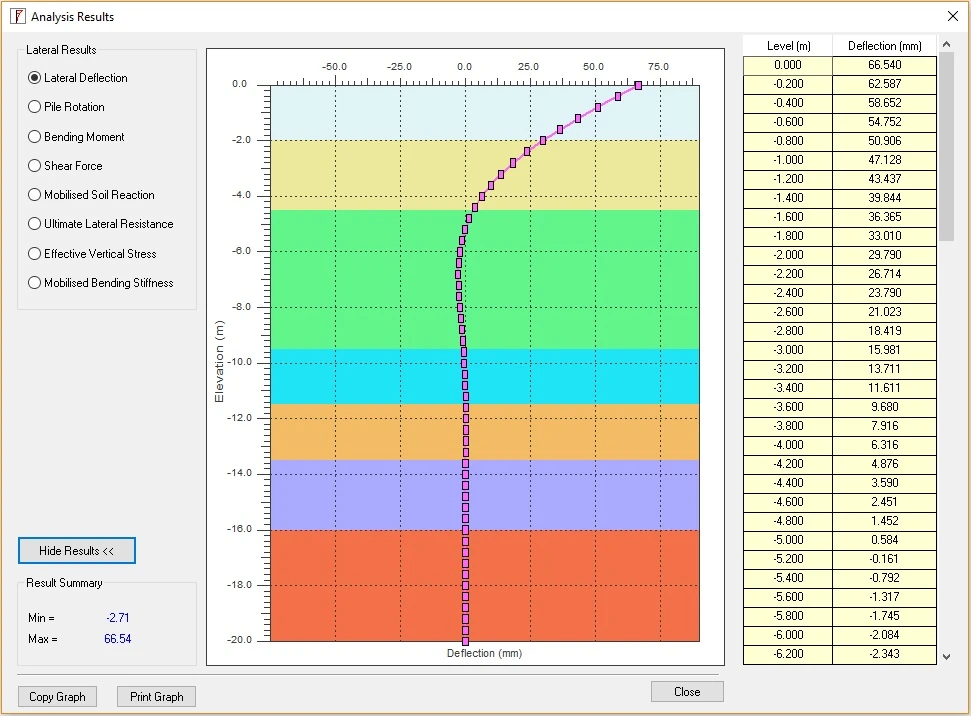


Some of the main features are:
1. Standard window-style dialogs, push buttons, drop menus, list boxes, EXCEL-like data grid cells, slide bars, radio buttons, check boxes and toolbars can be accessed in the program
2. Automatic generation of nonlinear soil resistance p-y curves for various soil types such as cohesive soils, cohesionless soils and rocks. By this approach, all p-y curves are reasonably placed into the relevant categories instead of being listed together. This helps the user to select the appropriate p-y curves in the analysis
3. Soil resistance p-y curves generated for cohesive soils include API soft clay, Matlock soft clay, Stiff clay with or without water (Reese) and Modified stiff clay without water
4. Soil resistance p-y curves generated for cohesionless soils include API sand, Reese Sand and Liquefied sand
5. Soil resistance p-y curves generated for rocks include Weak rock, Strong rock, Massive rock and Calcareous rock
6. A simple elastic-plastic soil resistance (p-y) curve is provided for all soil types for the preliminary lateral force analysis if required
7. Soil resistance (p-y) curve with using elastic subgrade modulus for all soil types
8. Soil resistance (p-y) curves for each node can be viewed, copied and printed. No need to specify the node locations before the analysis in order to access the p-y curve information. Once the analysis is completed successfully, p-y curves for all the nodes are automatically available to the user
9. Soil resistance (p-y) curves are automatically adjusted to consider the soil-layering effects in according to the approach proposed by Georgiadis
10. Both static and cyclic behaviour of soils can be considered
11. Pile batter and sloping ground surface can be modelled through an interactive dialogue where the geometry of the pile batter and ground surface slope can be graphically updated and viewed by the user with moving the relevant slide bars
12. P-multipliers can be defined by the user for each soil layer to consider the potential pile group effects for closely-spaced piles. The user also can use this option to purposely reduce the resistance of some soil layers if required
13. Multiple pile segments with different user-defined elastic bending stiffness or plastic bending moments can be specified by the user
14. Free-field soil lateral displacement loading along the pile length can be considered by the program at the specified node locations
15. Distributed horizontal shear forces and bending moments can be specified by the user at the node positions
16. Boundary conditions at the pile head such as free head, rigid head and partially restrained head with elastic rotational spring can be considered
17. An interactive dialogue is available to the user to specify the distributed loading along the pile length and the user is able to see the locations of the nodes with the applied loading
18. Different pile section types such as circular section, rectangular section, steel H-section, steel pipe section, octagonal section and user-defined section can be selected by the user
19. Detailed analysis results are presented in EXCEL-like format and can be easily selected and copied into the third-party program such as EXCEL for further processing
20. Basic capability of calculating pile settlement under compressive axial loading is available to the user. Load transfer t-z and q-w curves are automatically generated based on the pile installation type and soil type. The feature is very useful and it enables the user to carry out preliminary pile settlement analysis without the need to set up the analysis files in different programs. Detailed pile axial capacity and settlement analysis can be carried out by PileAXL 2014 which has more advanced features if required
21. Load-settlement curve can be generated by the program for the specified axial loading at the pile head. Preliminary estimations on the ultimate shaft resistance, ultimate end bearing resistance and ultimate axial pile capacity are carried out by the program and the preliminary results are shown on the load-settlement curve graph
22. Innovative soil layer and parameter input dialog is provided to help the user to enter the input data more easily and smoothly
23. A well-designed result output dialog is provided for the user to view all the relevant results graphically. Switching among different results is very straightforward. All the analysis results along the pile length are presented together with the soil layer geometry. Therefore, the analysis results within each soil layer can be viewed by the user conveniently from the graph of the results
24. Automatic generation of load deflection curves such as horizontal load vs top deflection, bending moment vs top deflection and maximum bending moment vs top deflection once the analysis is successfully completed
25. An interactive graphical presentation of pile and soil layer geometry is provided. Important changes in the input data such as pile length, the number of soil layers, soil layer name, soil layer thickness, soil layer colour, p-y model type, water table position, certain soil parameters and pile loading will be automatically updated in the graph. It is very convenient for the user to visually view the input change.